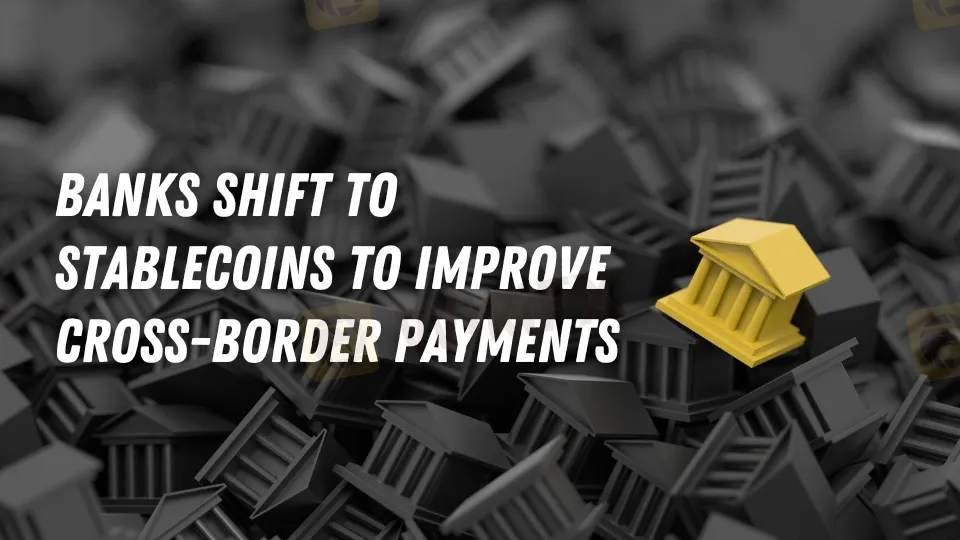简体中文
繁體中文
English
Pусский
日本語
ภาษาไทย
Tiếng Việt
Bahasa Indonesia
Español
हिन्दी
Filippiiniläinen
Français
Deutsch
Português
Türkçe
한국어
العربية
Banks Shift to Stablecoins to Improve Cross-Border Payments
Sommario:FV Bank supports USDT deposits to reduce fees and speed up cross-border payments. Discover how stablecoins are reshaping global transactions and banking.

Banks Eye Stablecoins for Efficient Cross-Border Payments
Cross-border payments have long been a barrier for worldwide transactions, characterized by high costs, poor processing times, and convoluted processes. However, a notable milestone occurred Thursday (Dec. 5), when U.S.-licensed FV Bank announced that direct USDT stablecoin deposits for international transactions are now supported. This move aims to make cross-border payments more efficient by eliminating the need for traditional wire transfers, lowering fees, and shortening processing times.
“This innovation positions us at the forefront of regulated financial institutions offering comprehensive stablecoin on-ramp and off-ramp services. Weve also integrated blockchain analytics tools to screen for AML and sanctions risks, ensuring regulatory compliance,” said Miles Paschini, CEO of FV Bank.
Paschini underlined that FV Bank's USDT direct deposit service is useful for both large-volume and small-scale foreign payments. This technology, which eliminates traditional bank wires, provides a faster, cheaper, and more transparent alternative to standard banking systems.
Stablecoins: A Game Changer in Cross-Border Payments
The existing cross-border payments system has long been a source of frustration, with high fees, slow processing times, and a reliance on several middlemen. Stablecoins, on the other hand, offer an appealing alternative by enabling near-instantaneous, low-cost transfers with increased transparency owing to blockchain technology.
Despite its advantages, moving cash between stablecoins and fiat currencies has proved difficult. On-ramp and off-ramp firms are now stepping in to bridge the gap, allowing consumers to quickly change stablecoins into regular money. Banks have a critical decision: change with the changing world or risk losing relevance.

How Stablecoins and Blockchain Could Transform Payments
The integration of stablecoin services into conventional financial systems has the potential to challenge banks' primary role of processing money transfers and conversions. If stablecoins become the preferred way for international payments, firms and consumers may turn to digital assets instead of traditional banking channels, cutting income from foreign exchange and remittance costs.
According to Sheraz Shere, General Manager of Payments at the Solana Foundation, “Blockchain solutions and stablecoins— theyve found product-market fit in cross-border payments. You get disintermediation, speed, transparency, and low cost.”
Regardless of the possible hazards, banks have a unique chance to integrate new technologies into their operations. Banks may position themselves as gateways to the digital economy and generate new income streams such as transaction fees and digital asset services by cooperating with stablecoin issuers or establishing proprietary on-ramps.
Stablecoins provide a mechanism for small and medium-sized companies (SMBs) to reduce payment expenses and increase cash flow. Similarly, remittances, which help millions of families throughout the world, may become more inexpensive and accessible.
Stablecoin's Future and Regulatory Challenges
While blockchain-based solutions are gaining popularity, regulatory issues remain a substantial impediment. Governments and central banks want to keep monetary policy under control while prohibiting criminal activity like money laundering.
In its 2024 annual report, the Financial Stability Oversight Council (FSOC) in the United States emphasized the growing use of blockchain-based solutions for cross-border payments. However, regulatory organizations are concerned that these developments follow existing financial regulations and safeguard the global financial system's integrity.
Final Thoughts
As the financial sector adopts stablecoins and blockchain technology, cross-border payments appear to have a bright future. Banks play a vital role in negotiating regulatory hurdles while incorporating these digital assets into their offerings. If broadly used, stablecoins might drastically cut the costs, time, and complexity of international transactions, benefiting both businesses and consumers. The next step will be to ensure that these technologies perform effortlessly inside the current regulatory frameworks.

Disclaimer:
Le opinioni di questo articolo rappresentano solo le opinioni personali dell’autore e non costituiscono consulenza in materia di investimenti per questa piattaforma. La piattaforma non garantisce l’accuratezza, la completezza e la tempestività delle informazioni relative all’articolo, né è responsabile delle perdite causate dall’uso o dall’affidamento delle informazioni relative all’articolo.
WikiFX Trader
WikiFX Trader
Rate Calc






